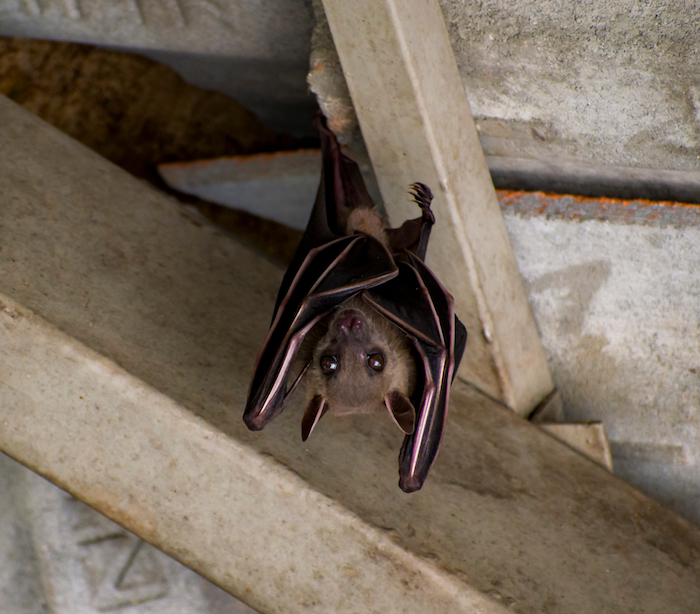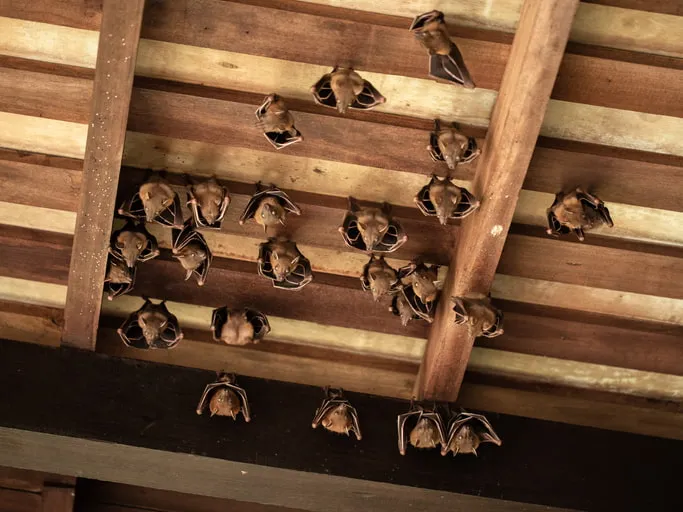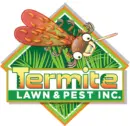BATS
If you’ve landed on this page, chances are you’ve got bats living in your attic. They are an important part of our natural environment and ecosystem, but having them in your home or workplace can be disturbing.
Bats are federally protected, meaning they can’t be killed or trapped. They are actually very beneficial to our environment as they eat crop-eating insects like sod webworms, flying termites, mosquitoes, and wasps.
Call Termite Lawn and Pest for proper and safe solutions.
Click here to read our Google reviews!

Expert Management
The only way to get bats out of a structure is with a bat cone (one-way valve). We use exclusion devices that allow them to leave but prevent them from re-entering the structure. Once the exclusion devices have been in place for 4 days and the bats are no longer in the structure, we seal off all entry points.
Proofing (or exclusion) plays an important role in getting rid of existing roosts. It also helps to discourage new or recurring invasions.
It is only possible to remove and exclude bats outside of maternity season. The maternity season runs from April 15 to August 15. Exclusion and removal is limited to the period from August 15 to April 15.
Bats play an active role in controlling mosquito populations, especially in Florida. They are also important predators of other night flying insects, helping to protect crops and farms from insects. Some bats can eat as many as 3,000 insects a night, which is about half their body weight. In some areas, they actively spread seeds and pollinate plants in certain areas.
We Are Certified Bat Control Specialists
There are “bat standards” in our industry. We are proud members of the National Pest Management Association (NPMA) and the National Wildlife Control Operators Association (NWCOA). We have the following certifications: “NWCOA Bat Standards Certified” and “NWCOA Certified Structural Bat Management Professional”. Most wildlife operators are not a member of NWCOA and are not even aware of these standards. Since there is no mandatory training or schooling required, most operators do not have the proper training or certification.
These standards are important because they protect bats, humans, and our environment. These standards include guidelines that cover proper exclusion and repair procedures, safety procedures, the use of PPE (personal protective equipment) and decontamination procedures. They also address health and disease issues such as:
- Bat Bugs (similar to Bed Bugs)
- Histoplasmosis
- Rabies
We safely remove and dispose of the guano (bat dung), which poses a public health hazard. We clean also equipment to prevent the spread of White Nose Syndrome.
Dangers and Concerns

Bats are a host to bat bugs, which are very similar to bed bugs.
When bats are expelled from a structure and their bugs no longer have them to feed on, they will seek a new host within the structure, often targeting pets or humans.
If we find bugs, we may need to administer a pesticide treatment. Companies that only perform wildlife removal usually do not have a pest control license and cannot legally treat for bugs. We are a fully licensed pest control company, and we can do it all.
FAQ About Bat Control
What to do if you find bats in your house?
If you find bats in your house, stay calm and avoid handling them, as bats can carry diseases like rabies. Close off the room to prevent the bat from moving to other areas of the house. If you feel comfortable, open a window or door to allow the bat to exit. For a larger number of bats or recurring issues, contact a professional pest control service to safely remove them and seal entry points to prevent future visits.
Why do I suddenly have bats in my house?
Bats may enter your house if they’re seeking shelter, especially during cooler seasons, or if there’s easy access through open windows, vents, or gaps in your attic or walls. They’re often drawn to dark, quiet spaces for roosting. If you’re experiencing a sudden increase in bats, it’s a good idea to inspect for openings and consider a professional assessment.
What attracts bats to your house?
Bats are typically attracted to houses that offer dark, secluded spaces, such as attics or eaves, where they can roost undisturbed. They may also be drawn to your property if there’s an ample food supply, such as flying insects, or water sources nearby. Ensuring that entry points are sealed and outdoor lighting is minimized can help deter bats from making your house their home.
What are the chances of getting rabies from a bat in the house?
The chances of getting rabies from a bat in your house are very low, but it’s still important to be cautious. Only a small percentage of bats carry rabies, and transmission typically occurs through direct contact, like a bite or scratch. If you’ve been in close contact with a bat, especially if it was in your bedroom while you were asleep, it’s best to consult a healthcare provider. For safety, avoid handling bats and contact a professional to remove them from your home.
Call us today for a free estimate on our wildlife control services! (407) 447-7378
Termite Lawn and Pest serves the entire Central Florida region including Orlando, Lake Mary, Kissimmee, and nearby areas. Explore our list of comprehensive services and service areas to discover how we can meet your needs.
Termite Lawn and Pest, Inc
4524 Parkway Commerce Blvd
Orlando, Florida 32808
Phone: (407) 447-7378
